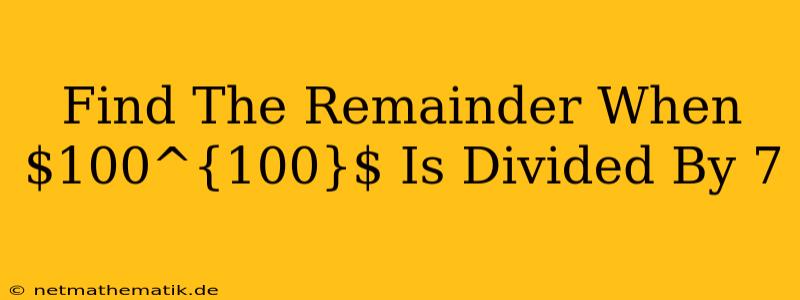Determining remainders in division problems, especially when dealing with large numbers, can seem daunting. However, there's a powerful tool in number theory called modular arithmetic that makes these calculations significantly easier. This tool allows us to focus on the remainders themselves, simplifying the process and revealing elegant patterns. In this article, we'll explore how to find the remainder when $100^{100}$ is divided by 7 using modular arithmetic.
Understanding Modular Arithmetic
Modular arithmetic, often referred to as "clock arithmetic," deals with remainders after division. The expression "$a$ is congruent to $b$ modulo $m${content}quot;, written as $a \equiv b \pmod{m}$, means that $a$ and $b$ have the same remainder when divided by $m$. For example, $13 \equiv 6 \pmod{7}$ because both 13 and 6 leave a remainder of 6 when divided by 7.
Finding the Remainder: A Step-by-Step Approach
-
Simplify the base: We begin by finding the remainder when 100 is divided by 7.
Since $100 = 14 \times 7 + 2$, we have $100 \equiv 2 \pmod{7}$. -
Apply the exponent: Now, we need to find the remainder when $2^{100}$ is divided by 7. We can do this efficiently by repeatedly squaring and finding remainders:
- $2^2 \equiv 4 \pmod{7}$
- $2^4 \equiv (2^2)^2 \equiv 4^2 \equiv 2 \pmod{7}$
- $2^8 \equiv (2^4)^2 \equiv 2^2 \equiv 4 \pmod{7}$
- $2^{16} \equiv (2^8)^2 \equiv 4^2 \equiv 2 \pmod{7}$
- $2^{32} \equiv (2^{16})^2 \equiv 2^2 \equiv 4 \pmod{7}$
- $2^{64} \equiv (2^{32})^2 \equiv 4^2 \equiv 2 \pmod{7}$
Notice the repeating pattern of remainders: 4, 2, 4, 2.... This pattern allows us to calculate $2^{100}$:
- $2^{100} = 2^{64} \cdot 2^{32} \cdot 2^4 \equiv 2 \cdot 4 \cdot 2 \equiv 2 \pmod{7}$
-
Final Result: Therefore, the remainder when $100^{100}$ is divided by 7 is $\boxed{2}$.
Key Properties of Modular Arithmetic
The elegance of modular arithmetic lies in its properties, which make calculations much simpler:
1. Congruence is an Equivalence Relation: This means that: - Reflexive: $a \equiv a \pmod{m}$ (any number is congruent to itself). - Symmetric: If $a \equiv b \pmod{m}$, then $b \equiv a \pmod{m}$. - Transitive: If $a \equiv b \pmod{m}$ and $b \equiv c \pmod{m}$, then $a \equiv c \pmod{m}$.
2. Congruence Preserves Operations: - Addition: If $a \equiv b \pmod{m}$ and $c \equiv d \pmod{m}$, then $a + c \equiv b + d \pmod{m}$. - Subtraction: If $a \equiv b \pmod{m}$ and $c \equiv d \pmod{m}$, then $a - c \equiv b - d \pmod{m}$. - Multiplication: If $a \equiv b \pmod{m}$ and $c \equiv d \pmod{m}$, then $ac \equiv bd \pmod{m}$.
3. Fermat's Little Theorem: If $p$ is a prime number and $a$ is an integer not divisible by $p$, then $a^{p-1} \equiv 1 \pmod{p}$. This theorem can be very helpful for simplifying calculations involving large exponents.
Applications of Modular Arithmetic
Modular arithmetic has wide-ranging applications in various fields, including:
- Cryptography: Used to secure sensitive information by employing complex mathematical operations based on modular arithmetic.
- Computer Science: Essential for tasks like error correction and data encryption.
- Number Theory: Fundamental for understanding and proving important results about integers and their properties.
- Calendar Systems: Used to calculate days of the week or dates based on specific rules.
Conclusion
Finding the remainder when $100^{100}$ is divided by 7 may seem daunting, but modular arithmetic provides a powerful tool to tackle such problems. By understanding its properties and applying them strategically, we can simplify calculations involving large numbers and uncover elegant patterns. The concepts explored in this article, along with the wide-ranging applications of modular arithmetic, showcase its importance in various fields, demonstrating its influence on our understanding of numbers and their relationships.
